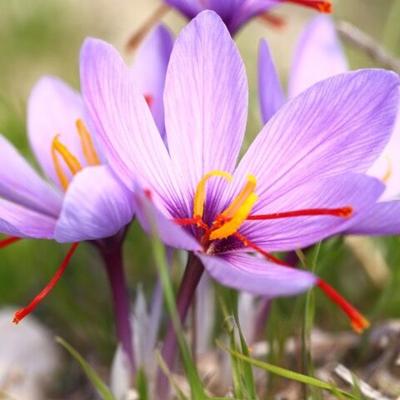On the shelves of garden centers in the month of October you will find enticing selections of tulips, daffodils, alliums, crocus, snow drops, and assorted other lesser-known bulbs - all of which, if planted this month, will start blooming in late winter and on into spring. Collectively, we refer to these as spring blooming bulbs. There is however, a couple of exceptions. Mixed in with these spring bloomers are two bulbs that will actually bloom in the fall, one of which is blooming in yards all around the Puget Sound as we speak.
If you have happened to notice in your neighborhood clusters of pink goblet-shaped flowers approximately 5 to 6 inches tall, usually planted in groups under deciduous trees or in rockeries (and sometimes even in casually cared for lawns), you are probably observing Colchicum autumnale. This is a bulb in the lily family that sends up flower stalks in October and usually blooms for 2 to 3 weeks, depending on the weather. After the flowers fade, 8 to 14-inch upright leaves will then sprout in groups of 6 to 8 and remain green until they go dormant in early summer. In the following October, the whole process starts all over again.
Colchicums are an interesting bulb in that they are considered poisonous if eaten but have been used for hundreds of years as a treatment for gout. An extract from them called colchicine is also used in the horticultural field to develop polyploid varieties that have multiple sets of chromosomes, the results of which often leads to desirable traits such as larger more colorful flowers or double blooming ones or simply overall stronger performers. I recall experimenting with colchicine way back when I was in college in the late 60’s.
As to where to plant colchicums, they are quite happy interspersed among low groundcovers such as vinca, creeping jenny, ajuga, creeping thyme, or sedums — all of which will help hold up their somewhat floppy flowers. The pink-purple flowers contrast nicely with the silver leaves of lambs ear and combine well with purple asters, pink chrysanthemums, and plants with purple foliage. They seem to tolerate sun or partial shade exposures and need reasonable drainage or they will rot. Other than that, they are a “plant and forget it” type of addition to any garden.
Along with colchicums, you can also find a true crocus called Crocus sativus or saffron crocus that looks a lot more like the traditional spring bloomers we all look forward to after a dreary winter, only it blooms in the fall. Saffron crocus has been cultivated commercially for over 3,500 years for its prized stigmas that produce a spice for flavoring foods and also a dye for coloring fabrics. The plant has purple to lavender flowers that appear in fall for a 1 to 2-week period when the saffron spice can be collected from the bright red stigmas. If you are thinking that you would like to start growing your own saffron, just remember that it takes 150 to 200 flowers to make one gram of saffron. So either plant a ton or plant to just enjoy their beautiful flowers.
Saffron crocus should be planted 4 inches apart and 4 inches deep in well-drained soil with moderate levels of organic matter in full sun. The corms will multiply each year and can be divided to produce more plants. Plant them in borders, walkways, rock gardens or in mass plantings.
You can find both of these fall bloomers on shelves at garden centers during this month, but they are always in short supply so it is best to get them early. Get some started this fall and you can enjoy them for many years to come. Stay safe and keep on gardening!
Steve Smith is the owner of Sunnyside Nursery in Marysville and can be reached at [email protected].


(0) comments
Welcome to the discussion.
Log In
Keep it Clean. Please avoid obscene, vulgar, lewd, racist or sexually-oriented language.
PLEASE TURN OFF YOUR CAPS LOCK.
Don't Threaten. Threats of harming another person will not be tolerated.
Be Truthful. Don't knowingly lie about anyone or anything.
Be Nice. No racism, sexism or any sort of -ism that is degrading to another person.
Be Proactive. Use the 'Report' link on each comment to let us know of abusive posts.
Share with Us. We'd love to hear eyewitness accounts, the history behind an article.